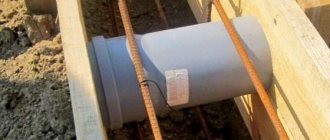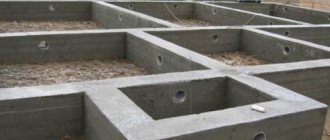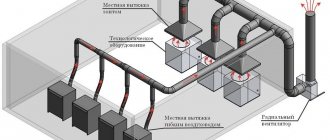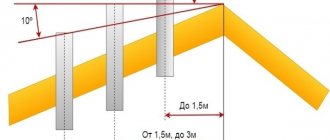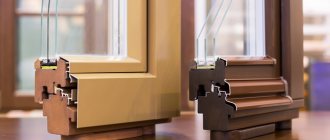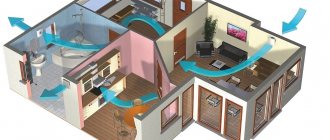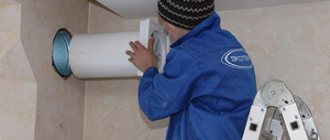The ventilation system of a private house should ensure a flow of fresh air into all rooms of the house and stimulate its renewal. The air duct system and openings for air flow are called supply air. Air ducts and exhaust openings are exhaust. Everything seems to be simple.
But in practice, the question of the most efficient design of a ventilation system is one of the most controversial. One of the most controversial issues is whether ventilation can be vented into the attic. It may be better to dispose of waste and contaminated air mass directly, i.e. through the wall?
In the article we presented, all aspects of constructing a ventilation system for a country house are discussed. We will introduce you to the regulatory requirements and nuances of the organization. Our recommendations will help you decide on the most practical option.
What is attic ventilation
Free air exchange between the under-roof space and the street is carried out through gaps and holes.
Holes in the ridges and under the roof overhang work most effectively. Positioned in this way, they use the pressure of wind and heat emanating from the ceiling of the house. If the ventilation of a cold attic in a private house is equipped correctly, in one hour the air goes around the entire roof twice from the inside. The movement of flows is directed from below from the vents under the eaves upwards to the ridge plates with special holes. If the roof is insulated, a gap of up to 5 cm wide is left between the roofing material and the insulation for the free passage of air.
The best exhaust is ensured by a combination of vents in the ridge and pitched elements mounted near the ridge. For tiled roofs, tiles are made with vents for air exchange.
And another way to ventilate attics in private homes is to install deflectors (turbines for ventilation) that provide mechanical draft. The method is good for ventilating an insulated attic above the attic.
The slight slope of the roof must also be taken into account when planning the ventilation of a cold attic. Vents in the ridge can be covered with snow, so they are replaced with pipes, the height of which should be higher than the snow cover.
The most ancient method of ventilation is a ventilation window in the attic. To ensure excellent air exchange in a cold attic, a combination of vents under the eaves, in the ridge and dormer windows is quite sufficient.
Ventilation of the cold attic of houses with a hip roof is different in that the house does not have gables. Therefore, there is nowhere to install ventilation windows in the attic. Thus, cold attics under hip roofs are ventilated using ridge and eaves vents.
It is more difficult to arrange the ventilation of the attic above the attic. Here, ventilation is provided by cracks in the roofing pie and mechanical means of traction. The ventilation outlet to the attic is hidden in the columns.
Main functions
The process of air exchange in a room consists of regulating heat exchange processes and maintaining optimal environmental indicators - temperature, humidity level, speed of movement of air masses.
The engineering system, equipped in accordance with established technical requirements, ensures the free flow of air and its movement in space due to installed dormer windows, vents, aeration devices of various designs and other openings.
The device of normally functioning ventilation is necessary especially if equipment for a supply and exhaust ventilation system or ducted air conditioner is located within the non-residential space. If the condensate that settles on it is not drained in a timely manner, repairs will have to be done very often.
The functional purpose of the system is the regular supply of the required volume of air and its subsequent removal, which contributes to:
- reducing moisture in the room;
- providing the necessary microclimate;
- preventing the formation of condensation and the development of fungus;
- creating continuous air exchange;
- preventing deformation of rafters in the building.
The organization of ventilation should be carried out both in a warm and in an uninsulated attic. In the summer, the roof surface heats up to high temperatures, transferring most of the heat to the lower part of the house.
In the presence of ventilation devices, the temperature inside the entire building decreases, which reduces the load on the air conditioning system, if present.
High humidity in the autumn-winter period affects the microclimate of the attic. At the same time, the thermal insulation qualities of the structure will be significantly reduced, because the water contained in the insulation and materials will contribute to heat loss. Therefore, an air exchange system is equipped to remove excess moisture.
Due to the large temperature difference inside and outside the room, condensation forms, walls, floors, floor beams, rafters, mauerlat, and vertical posts become wet. All this leads to rotting of the wooden components of the roof and the appearance of dampness.
Due to the difference between the temperature outside the roof and within the attic space, condensation forms on the inner surface of the roof or in the insulation. It must be removed through ventilation
To effectively ventilate the room throughout the year, without loss of heat in the house, the following technical standards are provided: for every 500 m2 of room, 1 m2 of ventilation openings is required.
In addition, in order to prevent the formation of water droplets on the beams of the structure, insulation measures should be taken - installing steam and waterproofing.
Characteristics of insulation
The choice of material for thermal insulation of ventilation pipes is carried out according to the following criteria:
- thermal conductivity;
- vapor permeability;
- resistance to various reagents;
- temperature limit;
- compliance with sanitary and hygienic standards
Each insulation for ventilation pipes has both its advantages and disadvantages, which are determined by its structure and technical parameters.
Mineral wool
It belongs to the traditional type of insulation and has good thermal insulation properties. In addition, mineral wool and other fibers are among the most affordable materials. However, when using it for internal insulation, a seal will be required, and for external insulation, reliable protection from moisture will be required.
Mineral wool with foil outer layer
Foamed polyethylene
Available in the form of shells that tightly fit the surface of the pipes, or in rolls. It is durable, long-lasting, affordable, resistant to moisture and chemicals. In addition, foamed polyethylene is not only a good insulator, but also helps to significantly reduce vibration of air ducts.
Expanded polystyrene
It is characterized by resistance to moisture, prevents the appearance of microorganisms and corrosion. This provides reliable protection of the metal from destruction, so polystyrene foam is used not only to insulate air ducts, but also to insulate the gas pipe.
Using shell-shaped insulation, you can provide access to the ventilation pipe for repair work.
Expanded polystyrene shell to protect ventilation pipes
Polyurethane foam
It is produced in the form of a shell and in many respects is the same as expanded polystyrene, but is more resistant to fire. Therefore, polyurethane foam will be a reliable barrier in the event of a fire and will not allow the fire to spread.
Basic SNiP requirements for ventilation systems
The requirements of SNiP can be considered redundant, but they still need to be fulfilled. They clearly prescribe not only the minimum required air exchange for each room, but also regulate the characteristics of each of the system elements - air ducts, connecting elements, valves.
The required air exchange is:
- for the basement - 5 cubic meters per hour;
- for living rooms - 40 cubic meters per hour;
- for the bathroom - 60 cubic meters per hour (plus a separate air duct);
- for a kitchen with an electric stove - 60 cubic meters per hour (plus a separate air duct);
- for a kitchen with a gas stove - 80 cubic meters per hour with one working burner (plus a separate air duct).
It is logical to equip the bathroom and kitchen with a forced ventilation system, even if natural ventilation is sufficient for the rest of the house. Exhausting air from the basement to avoid the concentration of carbon dioxide, which is heavier than air, is also often provided by a separate air duct.
The air circulation diagram in the house, made in the style of infographics, gives an idea of the flow of air flows. It is very important to check the functionality of the system after installing the duct system
Homeowners who are not ready to turn the roof of their house into a palisade of air ducts often think about how best to arrange ventilation communications within the attic. After all, I would like the design not to be too bulky.
Types of ventilation systems
Ideally, a non-residential attic should be cool in summer and dry in winter, and a residential attic should be comfortable for people at any time of the year. And this is precisely the goal that is pursued when choosing the desired ventilation option.
The classic type of attic ventilation in a private house is natural. Such ventilation is always based on physical laws: warm air rises and easily exits through the roof ridge. For this purpose, special ventilation holes are thought out in advance in the ridge.
Another way to provide natural ventilation is to install perforated soffits. We are talking about a special lining for cornices, designed not only to provide a spectacular look to the roof and its completeness, although many people think so. Where it is necessary to provide only an aesthetic appearance, but ventilation is not needed, solid soffits are installed. It is good to hide lighting wiring and other communications under them.
Perforated soffit is also used to cover the ceiling on a porch or veranda. Such roofing elements are made from plastic, copper, aluminum and steel. In the latter case, the soffits are covered with an anti-corrosion layer and a polymer coating. Perforated soffits allow air to pass through, but trap small birds and debris:
But if ecowool or sawdust was used as insulation, then they should be protected from blowing away:
Natural ventilation is also provided by vents. These are very simple designs for which a minimum of material is used. There are only two types of them: cornice and ridge:
All this can be complicated by turning the ventilation system into one single network. Then aerators and roof vents will come into use. Also, experts often recommend organizing the exit of ventilation pipes into one shaft, which will save a cold attic with a metal roof from condensation.
Forced ventilation is more expensive. Its task is to ensure that a special device controls air masses. Devices such as deflectors do a good job of ventilation. They are especially valued abroad, although in Russia they can increasingly be seen on the roofs of country houses. The essence of their work is simple: the device uses wind energy to increase traction in the pipe. A classic deflector usually has two parts: a stationary one, which is attached to the ventilation pipe, and a rotating one. The movable nozzle is a ball with vertical blades. A special bearing allows rotation along its internal central axis. Deflectors and weather vanes are installed, as a rule, on the ridge or closer to the ridge with a distance between elements of no more than 8 meters:
Please note that ventilation pipes must be routed above the roof of the house, and in no case should they be left in the under-roof space. Otherwise, warm, humid air from living rooms will begin to accumulate in the room, and condensation will quickly form on the roofing. All this threatens moisture getting into the insulation and onto the wooden rafters, which will not end well.
In voluminous roofs of complex shape, as an option, you can install a supply and exhaust system with a recuperator. True, it most often requires a constant power source - this should be taken into account. And if we talk about a residential attic, it generally needs its own ventilation system, separate from the whole house.
Calculation of metal roof ventilation
To choose the right ventilation equipment for a metal roof, you need to take into account the following parameters:
- roof area;
- roof shape;
- slope angle;
- aerator performance.
It is believed that metal roofing is the most vulnerable to moisture and needs maximum protection from vapors rising from the building. Therefore, such a roof is equipped with the maximum number of devices, including forced ventilation systems. Every builder knows that there are no restrictions on ventilation. Ideally, the air temperature both outside and inside the roof should be the same, and this can only be achieved through active ventilation.
There are no state standards for installing aerators for pitched roofs, so disagreements often arise regarding the frequency of their location. Some believe that it is necessary to install deflectors at the rate of one device per 40 m2 of roof, others argue that this is not enough and it is necessary to double their density. Some people prefer to install devices dotted at intervals of 0.5–0.6 m; there are even experts who advise embedding a valve into almost every sheet. Perhaps their opinion is dictated by the desire to protect the roof, but one can also assume that this is simply an attempt to increase the cost of the goods and services provided.
The main regulatory document regulating the construction of roofing is SP 17.13330.2011. Appendix “B” provides several examples of calculating the number of ventilation devices (aerators). Complex mathematical calculations that take into account many factors (climatic conditions and properties of materials) given in the document are for informational and advisory purposes only. All calculations are given for flat roofs. Regarding pitched metal roofing, it is noted that the ratio of the area of ventilation ducts to the area of the horizontal projection of the roof should be 1/300, and a table is given of the recommended height of the ventilation duct depending on the angle of inclination of the roof.
Cold attic: is ventilation needed?
In cold attic spaces there is a constant change in temperature, so the ventilation system must be adjustable. When building a house with your own hands on the roof, the lattice and rafters may not be completely closed, or lining is used, which has open intervals for air circulation.
And also the need for ventilation will depend on the outer cover of the roof. If slate or ondulin is used and a film is installed to provide vapor barrier or windproofing functions, then designing ventilation is not required.
Air circulation will occur naturally. After all, this roof is capable of allowing air to pass through. And also additional ventilation passages will be obtained during installation of the material. The resulting seams and skates allow air to pass through well.
When using metal tiles, there is one factor to consider. Even when installing the film under this material, condensation will still form, so it is necessary to provide ventilation.
If the house has a gable roof, then ventilation outlets are made in the gables of the openings. For air circulation, you can leave gaps of the same dimensions when sewing fronts and wind overhangs.
Some buildings have stone gables. In this case, you make small holes in the wall through certain areas with your own hands. This procedure avoids the appearance of stagnant air. This attic ventilation in a private home requires periodic adjustment.
To do this, it is necessary to provide for closing the holes made, as well as installing a grill on them so that foreign objects or small insects do not penetrate into it.
Cold attic ventilation design
Ventilating a cold attic is a fairly lightweight design that you can do yourself without any problems. To design and create a system, you need to know the basic aspects of the theory and have basic skills.
Creating a ventilation system in a cold attic in a private home is an easy task. It works due to the large volume of air and the absence of any obstacles to its normal circulation. The described ventilation method can be created by ensuring ventilation of the attic using several structures: eaves overhang, gable windows, grilles, roof ridge and ridge, etc.
For rooms with a gable roof, the best option would be to choose gable windows or eaves overhangs. They are best suited for designing an attic ventilation system with this type of roof.
If your cash reserves are quite meager, then as a budget alternative, you can use the option of using conventional grilles. Usually, they are installed in the amount of two pieces, where one can be adjusted, and the second is static, but at the same time the vents face downwards. As an additional accessory, a mosquito net can be attached to them, which will block access to insects.
The hip roof structure does not have gables. Therefore, to create a ventilation system, only cornice overhangs can be installed on them. In this case, the air is exhausted through the roof ridge.
The most difficult situation arises when working with valleys. Due to their specific design, it is quite difficult to ensure ventilation when working with them. However, this can be done using spot cornice aerators.
Features of warm attic ventilation
Modern heating systems very rarely use a natural air circulation system. Therefore, when converting an attic space into an attic, it is necessary to ensure absolute ventilation.
For a roof made of sheet metal and flexible tiles, it is necessary to sew counter battens, rafters and sheathing. Ventilation of a warm attic, the roof of which is made only of metal, is carried out using specialized windproof films - geosynthetics.
For roofs covered with slate, the use of counter battens is not necessary, since the attic will be ventilated in the same way as in other rooms.
Ventilation in the attic with attic
Ventilation of a warm attic in a private house is more difficult to arrange. Air movement in the under-roof space is only possible between the rafters. Therefore, it is necessary to resolve the issue of ventilation at the stage of attic construction. A space of 2-3 cm should be left between the layer of waterproofing and thermal insulation. Which additional layers of roofing cake should be used depends on the material with which the warm attic is sheathed. Ventilation under flexible tiles requires the installation of a counter batten. The metal sheathing must be supplemented with a layer of windproof film.
Ventilation of the attic above the attic is provided according to a similar principle: inlets - soffits - on the overhang, outlets on ridges.
The openings on the ridges and eaves must be located along the entire length in order to ventilate the entire roof, preventing stagnation of air and steam in individual spaces.
The attic itself is ventilated in the same way as any other living space. Air from the street enters through a window or supply valve and exits through the ventilation pipe along with excess moisture.
The right approach to insulation
To answer the question: how to insulate a ventilation pipe in a private house correctly and at the same time economically, you need to understand the reasons for the appearance of condensation. Temperature differences always lead to the appearance of condensation, but the most abundant release of “dew” is observed during the period of active contact between warm and cold air. The closer it can be moved to the outlet of the pipeline, the less potential danger and damage from condensate will be.
The ideal case is considered to be a situation in which the mixing of cold and hot air occurs in a section of the ventilation pipe located outside the building. But this is not always possible to implement in practice.
Therefore, for chimneys and air ducts in an unheated attic, insulation of the ducts is considered mandatory. Thanks to this, it will be possible to remove the “wet” zone - the place where dew is most actively formed - beyond the walls of the building. This solution will help, even with the active appearance of a large amount of condensation, to prevent moisture from penetrating into the walls, causing the appearance of dampness, fungus and other related troubles.
Finding the optimal location
A vertical chimney from a heating stove, fireplace or gas boiler, thanks to the release of hot air, will be completely cleared of moisture during the heating process. Horizontal air ducts, the outlet of which is located in the wall, should initially be installed with a downward slope of at least several degrees. This allows accumulated moisture to drain outside rather than inside the room. Therefore, the most important point before insulating such air ducts is to check whether there is a slope for its removal. Otherwise, even insulated ventilation pipes will become a source of problems in the future, albeit noticeably later than without any thermal insulation at all.
A mandatory place for insulating air duct pipes is an unheated attic space. It is here that the temperature difference during the cold season becomes a source of problems due to the formation of moisture. Condensation on them, regardless of whether plastic or metal pipes are used, forms both inside and outside.
Choosing the best material
In order for the thermal insulation of any plastic, metal and various other ventilation pipes to be quite effective, but also not to hit the budget, you should choose the right insulation. Today there is a fairly wide selection of materials for this, both affordable and quite expensive. The most recommended options are the following types of insulation:
- Mineral wool. An inexpensive fireproof option available at almost any hardware store. The downside of the availability of mineral wool is the complexity of installation and the need for its subsequent protection with foil or galvanization. Afraid of moisture.
- Stone wool. It has the advantages of mineral wool, as well as its disadvantages. Over time, it cakes and loses its thermal insulation properties.
- Polyurethane foam and polystyrene foam. Detachable structures for pipes of a certain diameter. Inexpensive, but providing excellent heat and moisture insulation. The disadvantage of the materials is their high fire hazard and rather low resistance to mechanical damage.
- Foamed polyethylene. Insulation offered in the form of ready-made tubes of different diameters. Inexpensive, has good thermal insulation properties, and is not afraid of moisture. The disadvantage is the need to put a heat insulator on the duct pipe, which is inconvenient or even sometimes impossible.
The choice of how to insulate the ventilation pipe is made by everyone himself. The basic rule that it is recommended to rely on when choosing is to purchase the material that will most fully solve the problem of condensation in a private ventilation network.
Natural ventilation with access to the attic
Gravitational ventilation, also known as natural ventilation, ensures air circulation according to the principle familiar from school: warm air is lighter than cold air. Warm air rises through exhaust ducts located as high as possible. Cooler air from the supply ducts enters the house.
Ventilation ducts in a one- and two-story private house can be combined into one system only if there is a good ventilation system in the attic itself. This reduces the number of air ducts on the roof
If effective under-roof ventilation is properly arranged in the attic and in the roof pie, then the exhaust air exhaust systems can be fully or partially combined.
The circulation and removal of contaminated air mass within the attic will be ensured by:
- fan risers;
- aerators (an air duct with access to the street, which forcibly ensures constant air circulation in the attic);
- proper installation of a roofing pie (the simplest is ventilation using two gaps under the roof and above the rafters);
- roof vents that cut directly into the roof system.
If a natural ventilation system is organized within an unheated attic, a rational solution is to combine all the ventilation pipes in the attic to be discharged through a common ventilation shaft.
A single riser vent can solve condensation problems in your attic. The natural ventilation system closes on it
If the attic is sufficiently ventilated, condensation will not accumulate in it. Unfortunately, roof vents or attic gaps do not always provide it fully.
Ventilation of the cold triangle of an unheated gable roof (called a gable or gable) is carried out by installing ventilation windows or openings with access to the street. This ensures there is sufficient air circulation in the attic
Dormers and attic vents that can be closed and opened should provide more air circulation than other methods of natural attic ventilation. For example, supply and exhaust openings drilled in the gables.
Doors and hatches to the upper attic floor
At the entrance from the stairs to the attic and to all upper floors, it is advantageous to install an entrance door that blocks the flow of air from the lower floors and divides and isolates the air space of the floors into independent blocks.
Ventilation on the floor will work more efficiently if you choose a door with a good seal and install a door closer that constantly returns the door to the closed position.
The topmost step of the stairs, directly in front of the door, must have a tread width of at least 60 cm.
For the purpose of dividing the air space of floors, doors can also be installed on the lower floor, at the entrance to the stairs upward.
The hatch acts as a door to the country attic. Approaches to the hatch opening must be fenced on three sides. The height of the fence is at least 0.9 m.
The hatch opens easily and smoothly thanks to gas springs (gas lifts) or an electric drive. In addition, the hatch must have a locking device in the open position. The hatch can be ordered from a hatch manufacturer, or you can make it yourself.
When making it yourself, experts recommend reducing the weight of the manhole cover and installing two gas elevators (you can choose automobile ones). Gas elevators must be installed with the rod down, and the cylinders must be attached to the hatch flap.
Gas springs - lifts are selected according to the location on the finished lid. Measure the force in kg. to lift the finished sash, convert to Newtons (kg x 10 = N), add 30% to the resulting value and determine the total power of the gas springs. Next, purchase a set (2 pieces) of gas elevators in the store with a capacity within the calculated values.
System of dormer windows and vents
One of the common measures for arranging attic ventilation in a private house is air exchange carried out by dormer windows. In this case, you don’t need to use a system of holes, vents and gaps. According to experts, this method is not extremely effective, but condensation does not accumulate in the room. The rules are as follows:
- The size of such windows should be at least 60x80 centimeters.
- Windows are installed on opposite gables.
- The windows are placed at an even distance from the cornice, the sides of the building and the ridge.
- The distance between two adjacent windows is at least one meter.
- The window can be installed directly into the ventilation grille in the attic.
This method of air exchange is popular in the construction of dachas and country houses. But there is also a disadvantage of such a system: air can stagnate under the dormer window and above it. But if you choose high-quality building materials and carry out the installation correctly, condensation will not accumulate in the attic space. Another, simpler way is to place vents. So how to create ventilation yourself, without resorting to the help of specialists?
In a private house, you can do the ventilation of a cold attic yourself. Evidence that condensation has accumulated is the appearance of an unpleasant smell of mustiness and dampness. Violation of comfort prompts many to immediately take up tools and begin fixing problems. In order for the ventilation system to ensure optimal air exchange, condensation does not accumulate and heat loss does not occur, it is important to pre-design all elements. If the roof is gable, the arrangement will not raise questions or problems. After the planning stage, you can start working:
- Vents are made in the gables.
- Wind slopes are covered on the sides of the roof with wood.
- All cracks are made uniformly, creating airflow over the entire surface of the attic.
Important! If the gables are made of stone, then there can be no gaps, and, armed with a tool, you need to make a couple of dormers in the surface.
DIY installation
Before you start arranging the attic ventilation with your own hands, you need to create its design, carefully consider the layout of its components, and write down on paper the sequence of work. During the preparation process, it is imperative to inspect all areas of the attic space, take the necessary measurements, and note the design features of the attic. When performing forced ventilation, it is necessary to select an exhaust fan with the appropriate technical characteristics. Sequence of installation work:
- In the diagram, according to the established designations, the fixation points of the valves and the area for laying the exhaust pipe are marked.
- You need to drill holes in the roof using a drill or hammer drill. These works are carried out very carefully so as not to damage the layers of the roofing cake, the design of which includes roofing, sheathing, waterproofing, insulation and vapor barrier layers. Holes for supply valves are made in the cornice or pediment. You should definitely take into account the placement of supply and exhaust ducts. The first ones are equipped below.
- Valves are being installed in the wall. A tube is inserted into a pre-drilled hole, which is covered with a grille on the street side. A filter is installed on the inside and the valve body is attached. All these elements are included in the valve delivery kit. The gaps between the structural elements and the wall surface are carefully sealed.
- On the roof surface where the hole for the pipe is drilled, the lining is securely fixed, and the quality of sealing of the connecting sections is checked. Next, the pipe is installed strictly vertically. It is imperative to maintain all calculated distances.
- A fan is mounted to the pipe on the inside of the building, and a deflector is mounted on the outside. The ventilation system is ready for operation. The effectiveness of its work is tested over the course of several days.
It is important to understand that properly equipped attic roof ventilation is one of the conditions for comfortable living in a country house. When arranging it with your own hands, it is imperative to comply with established building standards, design it together with the structure of the house and equip it at the stage of erecting the roof of the building.. https://www.youtube.com/embed/VGCQE8ZgaSE
Common myths about ventilation
Some people have doubts about the need for ventilation. Therefore, disagreements arise. Let's try to figure out whether it is possible to do without this system:
- Heat escapes through ventilation in winter. This is the most common opinion. If it takes a long time to heat the house, and cooling occurs very quickly, then air exchange does not affect this problem in any way. This is due to shortcomings when installing insulation materials. But if the insulation is of poor quality, it can release moist air into the attic. As a result, condensation appears and wooden floors begin to rot.
- Ventilation of a hip or hip roof is only necessary in summer. In fact, if air exchange is disrupted in winter, icicles will grow and mold and mildew will appear.
- It doesn't matter how much area the ventilation hole will occupy. This opinion is erroneous and it is not recommended to place holes by eye. Such ventilation will cause poor air circulation. It is worth adhering to a certain scheme: for every 500 m2 there is 1 m2 of ventilation.
How to make accurate calculations?
The optimal climate in the attic is maintained if the air in it is completely replaced twice a day. This avoids excess moisture and protects the insulation from dampness.
Let's do the math. For example, installing windows on gables or louvered grilles ensures air replacement at a rate of 1/2 per hour. If you install a more complex forced ventilation scheme, the air exchange rate will increase to 5 per hour. However, increased ventilation to a certain extent increases heat loss. Therefore, it is important not to go too far and the most appropriate amount of air exchange in the attic is still considered 1/2 per hour.
If we talk about more accurate calculations, roofing manufacturers usually indicate 0.32 square meters of ventilating surface per 100 square meters. This formula achieves an ideal balance between air inflow and outflow. But if the situation is atypical and such ventilation is not enough, then the ratio is 0.32 square meters of ventilation for every 50 square meters of floor.
And to implement proper ventilation you will need the following elements:
A few final tips
- pay attention to the strength of the ventilation, it must withstand any weather fluctuations;
- you can put continuous soffits under eaves with fine screening mesh. To prevent corrosion, the holes should be made of aluminum or plastic;
- to prevent the formation of frost in the attic, install vents inside the room between the rafters and make holes so that they cannot become clogged with debris;
- You can install a fan on the roof for better air extraction. The distance between it and the supply system must be at least 8 m;
- the air supply unit should be placed in the cleanest place in the attic;
- install a recuperator that can cool or heat the air, thereby preventing condensation from forming in a cold attic;
- equip ventilation pipes with grilles or diffusers;
At first glance, there is nothing complicated in arranging ventilation, but in fact it is better to take this issue seriously and consult with specialists. After all, the microclimate in the house and your health, as well as the durability of the building itself, depend on its quality.
